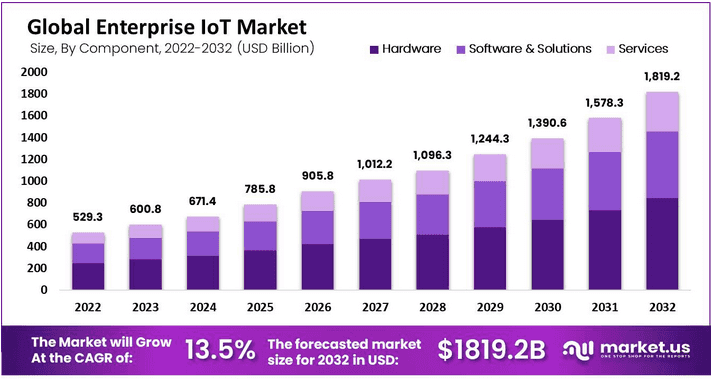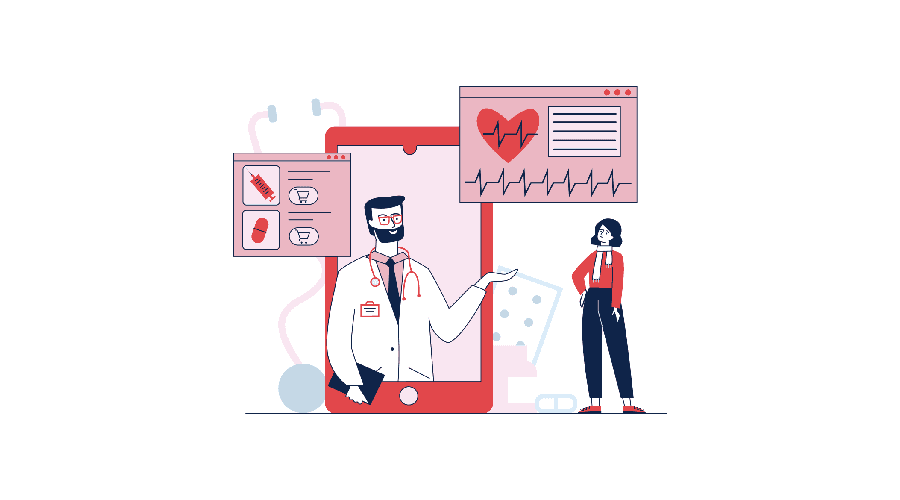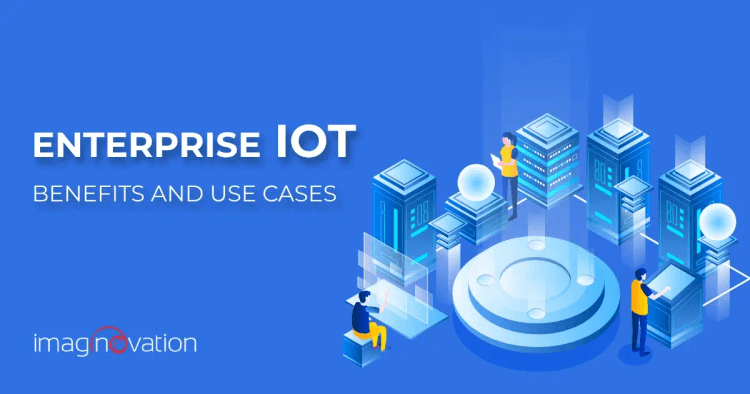Easier data collection. Higher productivity. Increased efficiency in asset utilization. These are just a few of the benefits that businesses stand to gain by implementing enterprise IoT. This technology enables companies to harness the power of IoT to optimize their operations.
While enterprise IoT may sound foreign to some, it’s a concept that has been gaining traction rapidly. So much so that it’s expected to grow at a compound annual growth rate of 14.1% in the next six years.
Businesses looking to set themselves apart or remain relevant in the fast-paced digital world can truly benefit from this technology. This article provides a comprehensive overview of enterprise IoT, including the benefits, common use cases, and implementation.
What Is Enterprise IoT?
Enterprise IoT is the widespread application of IoT in the industrial sector. In fact, it’s also referred to as the Industrial Internet of Things (IIoT).
Large organizations deploy enterprise IoT by embedding internet-enabled sensors in their machinery, equipment, and other assets. This allows them to capture and analyze relevant data for optimal efficiency and productivity.
Enterprise IoT is different from consumer IoT. With the latter, the end user is the consumer instead of the big organizations. So, the primary goal of consumer IoT is to help individuals automate everyday tasks using smart devices. Think smart light switches, smart watches, smart thermostats, and the like.
In contrast, enterprise IoT deals with a larger scale of operations. IoT solutions used in fleet management, supply chain management, and predictive maintenance are great examples of enterprise IoT.

The global Enterprise IoT market has been growing relatively steadily in the past few years. In 2022, it was valued at $529.3 billion. However, it’s expected to increase at a CAGR of 13.5%, reaching $1,819.2 billion in a span of eight years.
Benefits of Enterprise IoT
Are you considering implementing IoT into your business but aren’t sure of the benefits? Here are some of the perks you stand to gain:
Increased Efficiency
One of the biggest selling points of enterprise IoT is that it runs independently. It’s based on machine-to-machine communication with zero human intervention.
The fact that an IoT system can capture data round-the-clock and do so independently translates to maximum efficiency.
Company employees don’t have to spend hours collecting and processing data as the IoT system effectively handles these tasks. Whether it’s monitoring routes of delivery vehicles or tracking mileage, enterprise IoT makes these processes a breeze.
Real-Time Access to Data
Enterprise IoT systems are designed to collect data in real-time - a factor that immensely benefits businesses. The captured data is conveyed and shared instantly through Internet-connected devices. This not only minimizes delays but also reduces the risk of miscommunication.
To illustrate the benefit of real-time data, let’s consider the application of enterprise IoT in warehouses. If you have an IoT system, you can have each product logged and connected to the network.
This would allow the product’s movements to be tracked in real-time. So whenever the inventory of a particular product runs low, you can have new stock orders placed instantly and in the correct quantities.
Energy Optimization
One of the biggest expenses for any business is energy consumption. You need to keep the light bulbs on, the space heated and cooled efficiently, the surveillance cameras running round-the-clock, and so much more.
Still, this doesn’t mean that you have to spend a fortune on utility bills. By implementing enterprise IoT technology, you can use energy more efficiently and save money.
For instance, you can install sensors to determine your facility's most frequently used areas. Based on the data you collect, you can adjust the HVAC systems, lights, and other utilities to run at specific times.
Improve Customer Service and Experience
The secret to helping your business flourish is understanding your customers. The more you know about them, the more precise you will be when predicting their wants. This will then enable you to design products that address their pain points.
To achieve this, you need to collect relevant data. And this is where IoT enterprise tech comes in handy. It makes collecting, monitoring, and analyzing customer data easy, helping you understand customer behavior better.
For instance, on-floor cameras linked to AI or analytic systems can help retailers understand customer reactions to prices. Based on this, the retailer can increase/ decrease prices or offer alternative products.
Common Use Cases of Enterprise IoT
Here are some of the most popular applications of enterprise IoT:
Manufacturing
If there’s one sector that has benefited immensely from enterprise IoT, it’s manufacturing. This technology has been particularly helpful in predictive equipment maintenance.
Connected sensors are installed on heavy machinery to monitor their performance closely and detect unusual changes. The IoT system is configured to schedule maintenance whenever an error is detected.
This prevents the complete breakdown of equipment, which can lead to extended downtimes and pricey repairs.
Another way enterprise IoT is employed in the manufacturing sector is through smart security systems. By leveraging artificial intelligence, smart IoT-connected cameras can identify faces and alert officials if a stranger accesses the facility illegally.
Healthcare

Another sector that’s embraced enterprise IoT is healthcare. The IoT technology has proven beneficial in remote health monitoring and analyzing health-related data.
When it comes to monitoring, IoT-connected devices are used to track patients’ health parameters. These include blood pressure, ECG, blood sugar levels, and heart rate. Thanks to this, the gadgets can alert the patient whenever they detect impending danger.
Moreover, IoMT devices can relay patients’ health data to relevant health practitioners. This saves the patient from having to visit a clinic or health care institution physically, hence, saving time and money.
In some cases, IoT devices are also used to facilitate treatment. The continuous glucose monitor (CGM) is a good case in point. It monitors an individual’s blood sugar levels and adjusts the insulin pump accordingly.
Agriculture
Enterprise IoT has also improved the agricultural sector significantly through precise crop monitoring, livestock monitoring, and smart greenhouses.
Initially, greenhouse settings were adjusted manually. Modern IoT technology can easily adjust essential parameters through customized software. Sensors installed throughout the greenhouse plant can monitor the climatic conditions and adjust settings accordingly.
Similarly, agricultural firms have resorted to using drones to monitor crop growth efficiently. The unmanned aerial vehicles allow agriculturalists to observe large sections of land with ease. This enables them to identify looming crop diseases and nip them in the bud.
Transportation and Logistics
Enterprise IoT has also proven indispensable for businesses in the transportation and logistics niches.
The technology is particularly useful in monitoring the health of company vehicles or fleets. Connected sensors provide real-time stats regarding vehicle performance, such as tire pressure, mileage, fuel consumption rate, and more. This enables you to detect and repair issues early to avoid expensive breakdowns.
Enterprise IoT also helps businesses to optimize travel routes. They can recommend the fastest and most efficient routes by leveraging real-time traffic data. This enables you to avoid delays, and this translates to huge cost savings!
Retail
The retail sector has also seen a profound application of enterprise IoT, and understandably so. This technology has been useful in streamlining supply chains, enhancing the storage of goods, and improving customers’ shopping experiences.
When it comes to optimizing the supply chain, IoT sensors are used to track products’ lifecycles. The goods are monitored right from production to delivery. Such sensors help retailers know whether the products are delivered on time and in proper condition.
Many retailers also use IoT gadgets to automate various tasks, resulting in efficient store operations. Tasks such as lighting and temperature control can be controlled using IoT sensors, leading to cost and time savings.
IoT systems are also helping retailers track store traffic. Based on the findings, they’re able to improve a customer’s shopping experience by reducing wait times. For instance, a store owner can choose to redesign the layout, add special stations for complex procedures, and offer alternative payment methods, among others.
Challenges in Implementing Enterprise IoT
Theoretically, the enterprise IoT concept seems pretty straightforward. Leverage technology to capture and analyze data. Next, use this data as insight to transform processes and realize benefits.
In reality, though, IoT implementation is not as cut and dry. The trick is to familiarize yourself with the challenges you’re likely to face and, hence, look for appropriate solutions. Here’s a list of hurdles that most businesses face when implementing enterprise IoT:
Incompatible and Fragmented IoT Ecosystems
In an ideal world, all the components of an IoT ecosystem would work in perfect harmony.
Unfortunately, this is rarely the case. The myriad of IoT gadgets on the market makes universal compatibility virtually impossible. So, there’s a chance that the IoT solution you pick ends up being incompatible with the existing business systems.
The fragmentation of the IoT ecosystem presents another hurdle. There are dozens of vendors, service providers, and OEMs, each offering an exclusive IoT solution. This makes it hard to integrate different elements of IoT technologies.
Connectivity Issues
Depending on the industry, another challenge that an enterprise is likely to encounter is connectivity.
Here’s the deal: the quality of information captured by sensors and relayed to the network of IoT devices depends on routers—specifically, MAN, LAN, and WAN.
Unfortunately, the number of IoT-connected devices is growing at a rate faster than network coverage. As a result, some regions have really poor Internet connectivity. And this is hampering efficient data collection. The most affected are logistics, oil and gas companies with remote operations.
Handling Unstructured Data
There are two main types of IoT data:
- Structured - this is discrete data that can be easily categorized into rows and columns. Think dates, product IDs, transaction details, and so forth.
- Unstructured - this is data that cannot be organized in tables. Examples include social media comments, footage from security cameras, or traffic flow information.
The biggest proportion of data IoT devices collect is unstructured, making it difficult to process. For efficient analysis, the data has to be indexed and assigned a particular date and time. It should also be correlated with other data sources for easier processing and interpretation.
The complexity and sheer volume of the data collected can pose a challenge for enterprises looking to implement IoT solutions.
Develop IoT-Enabled Enterprise Solutions with Imaginovation
Tapping into the Enterprise IoT space can yield massive benefits for medium-to-large-sized businesses. It can lead to better asset utilization, improved customer experience and greater efficiency.
That said, implementing enterprise IoT into your organization can be challenging. At Imaginovation, we can streamline this process for you, leading to a seamless integration with existing infrastructure. We offer flexible enterprise IoT solutions as per your need. Contact us, and let us guide you on this digital transformation.
Let's Talk.
Ready to build an app, but not sure where to start?
We've got you covered. Click the button below to get started.





